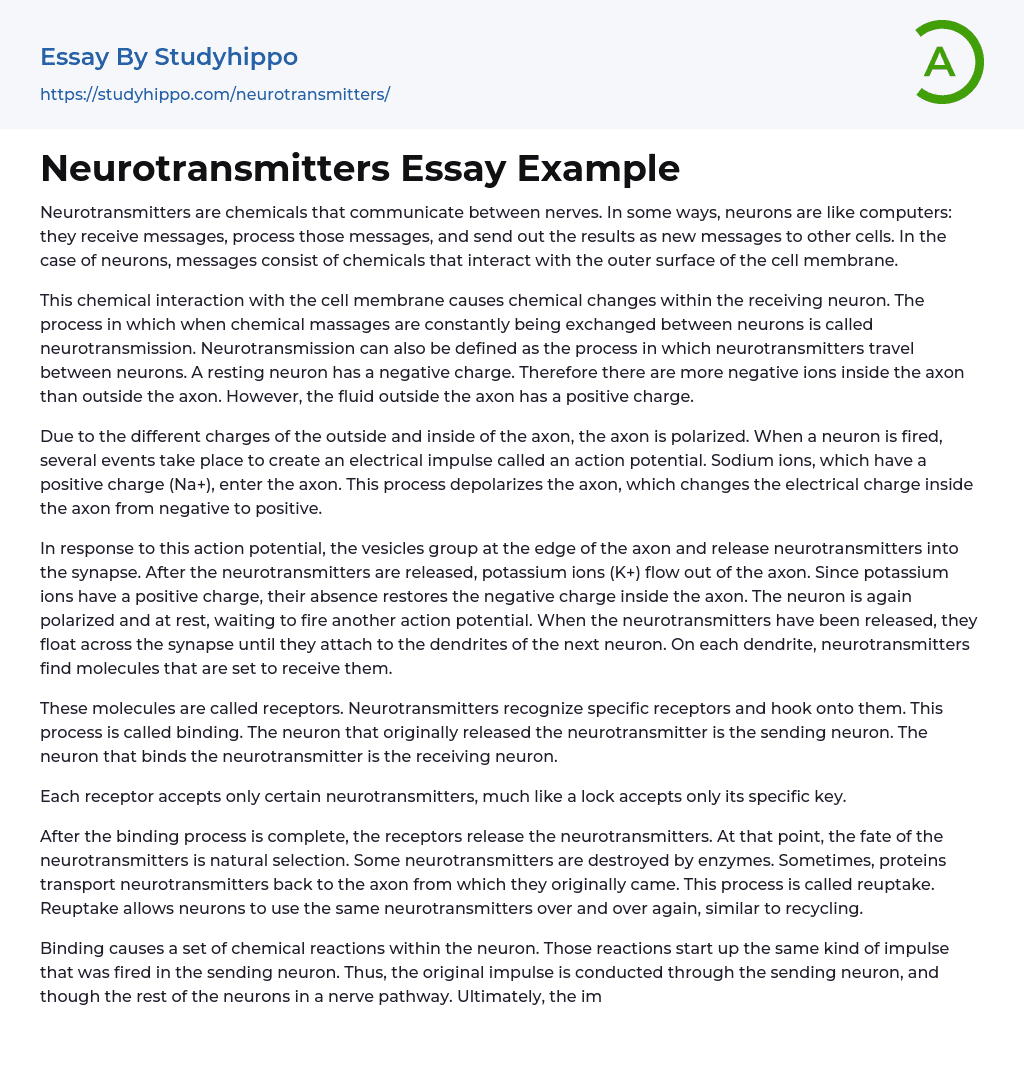Neurotransmitters are chemicals that communicate between nerves. In some ways, neurons are like computers: they receive messages, process those messages, and send out the results as new messages to other cells. In the case of neurons, messages consist of chemicals that interact with the outer surface of the cell membrane.
This chemical interaction with the cell membrane causes chemical changes within the receiving neuron. The process in which when chemical massages are constantly being exchanged between neurons is called neurotransmission. Neurotransmission can also be defined as the process in which neurotransmitters travel between neurons. A resting neuron has a negative charge. Therefore there are more negative ions inside the axon than outside the axon. However, the fluid outside the axon has a positive charge.
Due to the different charges of the ou
...tside and inside of the axon, the axon is polarized. When a neuron is fired, several events take place to create an electrical impulse called an action potential. Sodium ions, which have a positive charge (Na+), enter the axon. This process depolarizes the axon, which changes the electrical charge inside the axon from negative to positive.
In response to this action potential, the vesicles group at the edge of the axon and release neurotransmitters into the synapse. After the neurotransmitters are released, potassium ions (K+) flow out of the axon. Since potassium ions have a positive charge, their absence restores the negative charge inside the axon. The neuron is again polarized and at rest, waiting to fire another action potential. When the neurotransmitters have been released, they float across the synapse until they attach to the dendrites of the next neuron.
On each dendrite, neurotransmitters find molecules that are set to receive them.
These molecules are called receptors. Neurotransmitters recognize specific receptors and hook onto them. This process is called binding. The neuron that originally released the neurotransmitter is the sending neuron. The neuron that binds the neurotransmitter is the receiving neuron.
Each receptor accepts only certain neurotransmitters, much like a lock accepts only its specific key.
After the binding process is complete, the receptors release the neurotransmitters. At that point, the fate of the neurotransmitters is natural selection. Some neurotransmitters are destroyed by enzymes. Sometimes, proteins transport neurotransmitters back to the axon from which they originally came. This process is called reuptake. Reuptake allows neurons to use the same neurotransmitters over and over again, similar to recycling.
Binding causes a set of chemical reactions within the neuron. Those reactions start up the same kind of impulse that was fired in the sending neuron. Thus, the original impulse is conducted through the sending neuron, and though the rest of the neurons in a nerve pathway. Ultimately, the impulse reaches its final destination (muscle, organ). The result is a change in the way we think, feel, or act.
- Mutation essays
- Action Potential essays
- Blood essays
- Body essays
- Brain essays
- Childbirth essays
- Eye essays
- Glucose essays
- Heart essays
- Human Physiology essays
- Immune System essays
- Kidney essays
- Muscle essays
- Nervous System essays
- Neuron essays
- Poison essays
- Puberty essays
- Sense essays
- Skeleton essays
- Skin essays
- John Locke essays
- 9/11 essays
- A Good Teacher essays
- A Healthy Diet essays
- A Modest Proposal essays
- A&P essays
- Academic Achievement essays
- Achievement essays
- Achieving goals essays
- Admission essays
- Advantages And Disadvantages Of Internet essays
- Alcoholic drinks essays
- Ammonia essays
- Analytical essays
- Ancient Olympic Games essays
- APA essays
- Arabian Peninsula essays
- Argument essays
- Argumentative essays
- Art essays
- Atlantic Ocean essays
- Auto-ethnography essays
- Autobiography essays
- Ballad essays
- Batman essays
- Binge Eating essays
- Black Power Movement essays
- Blogger essays
- Body Mass Index essays
- Book I Want a Wife essays




